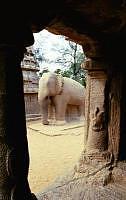Living gods of Tamil Nadu

Few things in India express the continuous presence of the gods better than the ancient, massive temple complexes of Tamil Nadu, says Edward Wong.
Walk through any city there and what catches your eye first are the soaring temple entrances known as gopurams, sacred skyscrapers decorated with a phantasmagoria of Hindu statues. Thousands of such statues adorn the Meenakshi-Sundareshwarar temple in Madurai, one of the holiest pilgrimage sites in India.
“Here, we have a proverb: ‘Where there is a temple, people can live,’ ” said Ram Kumar, a guide I had hired in Madurai. “The temple is the center of a person’s living space.”
Many of Tamil Nadu’s residents see the state as a repository of “pure” Hindu culture. In many ways, it is a country within a country, proudly preserving its ancient Dravidian culture, most noticeably in the widespread use of the Tamil language.
At one workshop, there was a statue of Ganesh who was typing on a laptop. “Computer companies like to buy these,” the workshop’s manager said.
This is India: the modern alongside the classically ancient.
Guide for sightseeing in Tamil Nadu
Based in Madurai, Ram Kumar, a guide recommended by the local tourist office, charges 300 to 400 rupees, depending on the length of the tour. He can also take you around other parts of Madurai, including the Royal Palace Compound, which has a stunning collection of Chola-era bronze statues, as well as an interesting library with Sanskrit manuscripts. His cell phone number is 91-984-263-6312, and his e-mail address is [email protected]
